 With many countries struggling to recover from the depression of the past few years, central banks are considering more and more doveish moves to kick-start lending. But with short-term interest rates in the USA, the UK and Japan close to zero, the scope for further cuts are limited. So what can central banks do?
With many countries struggling to recover from the depression of the past few years, central banks are considering more and more doveish moves to kick-start lending. But with short-term interest rates in the USA, the UK and Japan close to zero, the scope for further cuts are limited. So what can central banks do?
The first thing that can be done is to adopt a higher inflation target or to accept inflation above target – at least for the time being. This could be accompanied by explicitly targeting GDP growth (real or nominal) or unemployment (see the blog from last December, Rethinking central bank targets).
 The second option is to increase quantitative easing. Although in a minority at the last MPC meeting, Mervyn King, the current Bank of England Governor, argued for a further £25 billion of asset purchases (bringing the total to £400bn) (see MPC minutes paragraph 39). It is highly likely that the MPC will agree to further QE at its next meeting in March. In Japan, the new governor of the Bank of Japan is expected to include asset purchases as part of the policy of monetary easing.
The second option is to increase quantitative easing. Although in a minority at the last MPC meeting, Mervyn King, the current Bank of England Governor, argued for a further £25 billion of asset purchases (bringing the total to £400bn) (see MPC minutes paragraph 39). It is highly likely that the MPC will agree to further QE at its next meeting in March. In Japan, the new governor of the Bank of Japan is expected to include asset purchases as part of the policy of monetary easing.
The third option is for the central bank to provide finance at below-market rates of interest directly to the banking sector specifically for lending: e.g. to small businesses or for house purchase. The Bank of England’s Funding for Lending Scheme is an example and the Bank is considering extending it to other financial institutions.
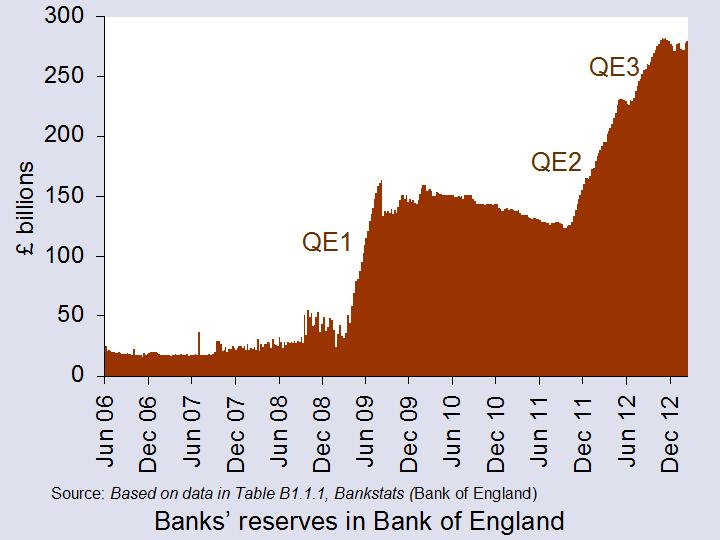 One other approach, mooted by the Bank of England’s Deputy Governor before the House of Commons Treasury Select Committee, is for negative interest rates paid on Banks’ reserves in the Bank of England. This would, in effect, be a fee levied on banks for keeping money on deposit. The idea would be to encourage banks to lend the money and not to keep excessive liquidity. As you can see from the chart, three rounds of quantitative easing have led to a huge increase in bank’s reserves at the Bank of England. (Click here for a PowerPoint of the chart.)
One other approach, mooted by the Bank of England’s Deputy Governor before the House of Commons Treasury Select Committee, is for negative interest rates paid on Banks’ reserves in the Bank of England. This would, in effect, be a fee levied on banks for keeping money on deposit. The idea would be to encourage banks to lend the money and not to keep excessive liquidity. As you can see from the chart, three rounds of quantitative easing have led to a huge increase in bank’s reserves at the Bank of England. (Click here for a PowerPoint of the chart.)
The following articles consider these various proposals and whether they will work to stimulate lending and thereby aggregate demand and economic recovery.
Central banks: Brave new words The Economist (23/2/13)
Phoney currency wars The Economist (16/2/13)
Analysis: Global central banks will keep taking it easy Reuters, Alan Wheatley (22/2/13)
Quantitative easing: the markets are struggling with a serious drug habi The Guardian, Larry Elliott (24/2/13)
Negative interest rates idea floated by Bank’s Paul Tucker BBC News (26/2/13)
Bank of England mulls negative interest rates Independent, Ben Chu (26/2/13)
BoE floats extending Funding for Lending to non-banks Mortgage Solutions, Adam Williams (26/2/13)
Funding for Lending Scheme failing to get banks lending Left Foot Forward, James Bloodworth (26/2/13)
Mortgage market boosted by lending schemes, says Redrow BBC News (26/2/13)
Widespread quantitative easing risks ‘QE wars’ and stagnation The Guardian, Nouriel Roubini (28/2/13)
Questions
- Consider each of the methods outlined above and their chances of success in stimulating aggregate demand.
- Go through each of the methods and consider the problems they are likely to create/have created.
- How important is it that monetary policy measures affect people’s expectations?
- What effects do the measures have on the distribution of income between borrowers and savers?
- What are annuities? How are these affected by policies of monetary easing?
- How has actual and anticipated Japanese monetary policy affected the exchange rate of the Japanese yen? How is this likely to affect the Japanese economy?
- Explain the sub-heading of the final article above, “When several major central banks pursue QE at the same time, it becomes a zero-sum game”. Do you agree?
 From early January to late February 2013, the average pump price of petrol in the UK rose by over 6p per litre – a rise of 4.7% in just seven weeks. There have also been substantial rises in the price of diesel.
From early January to late February 2013, the average pump price of petrol in the UK rose by over 6p per litre – a rise of 4.7% in just seven weeks. There have also been substantial rises in the price of diesel.
The higher prices reflect a rise in the dollar wholesale price of oil and a depreciation in the pound. From 2 January to 21 February the pound fell from $1.63 to $1.53 – a depreciation of 6.1% (see). Crude oil prices (in dollars) rose by just under 7% over this period. With oil imports priced in dollars, a weaker pound pushes up the price of oil in the UK. The price has then been pushed up even higher by speculation, fuelled by the belief that prices have further to rise.
 The higher price of road fuel, plus the general squeeze on living standards from the recession, with prices rising faster than wages, has caused a reduction in the consumption of road fuel. Petrol sales have fallen to their lowest level for 23 years. Sales in January 2013 were 99m litres down on the previous month’s sales of 1564m litres (a fall of 6.3%).
The higher price of road fuel, plus the general squeeze on living standards from the recession, with prices rising faster than wages, has caused a reduction in the consumption of road fuel. Petrol sales have fallen to their lowest level for 23 years. Sales in January 2013 were 99m litres down on the previous month’s sales of 1564m litres (a fall of 6.3%).
Not surprisingly motorists’ groups have called for a reduction in fuel taxes to ease the burden on motorists. They also argue that this will help to drive recovery in the economy by leaving people with more money in their pockets.

Equally not surprisingly, those concerned about the environment have welcomed the reduction in traffic, as have some motorists who like the quieter roads, allowing journey times to be cut, with resulting reductions in fuel consumption per mile.
The following videos and articles discuss the causes of the most recent fuel price rises and also examine the responsiveness of demand to these higher prices and to the reductions in real incomes.
Webcasts
 Rising petrol prices are ‘forcing drivers off the road’ BBC News, Richard Westcott (22/2/13)
Rising petrol prices are ‘forcing drivers off the road’ BBC News, Richard Westcott (22/2/13)
 Fuel prices ‘forcing drivers off road’ – AA BBC News (22/2/13)
Fuel prices ‘forcing drivers off road’ – AA BBC News (22/2/13)
 Fuel Prices Head For Highest Level Ever Sky News (22/2/13)
Fuel Prices Head For Highest Level Ever Sky News (22/2/13)
 Commodities Next Week: Fuel Prices Hit Fresh 2013 Highs CNBC (22/2/13)
Commodities Next Week: Fuel Prices Hit Fresh 2013 Highs CNBC (22/2/13)
 Ministers to blame for high fuel prices, says competition watchdog The Telegraph, Peter Dominiczak (30/1/13)
Ministers to blame for high fuel prices, says competition watchdog The Telegraph, Peter Dominiczak (30/1/13)
Articles
Petrol price surge adds 6.24p to a litre in a month The Guardian (22/2/13)
Petrol prices set for record highs as speculators and weak pound drive up pump costs again This is Money (22/2/13)
How are motorists saving fuel? NNC Magazine, Tom Geoghegan (9/3/11)
AA Report
Fuel Price Report (February 2013)
Data
Weekly road fuel prices Department of Energy and Climate Change
Energy consumption in the UK Department of Energy and Climate Change
Oil and oil products: section 3, Energy Trends Department of Energy and Climate Change
Europe Brent Spot Price FOB (Dollars per Barrel) US Energy Information Administration
Crude Oil (petroleum), Price index Monthly Price – Index Number Index Mundi
Questions
- Is it possible to calculate the price elasticity of demand for petrol from the data given? Try making the calculation.
- How important is the ceteris paribus (other things being equal) assumption when calculating the price elasticity of demand for petrol?
- Why is the long-run price elasticity of demand for road fuel likely to different from the short-run price elasticity?
- If wholesale oil prices go up by x%, will prices at the pumps go up by approximately x% or by more or less then x%? Similarly, if the pound depreciates by y% would you expect prices at the pumps go up by approximately y% or by more or less then y%? Explain.
- How has speculation affected fuel prices? Is this effect likely to persist? Explain.
- Under what circumstances would a reduction in road fuel taxes help to drive the recovery? Are such circumstances likely?
- Which groups in society suffer most from higher fuel prices? Is this reflected in their price elasticity of demand and if so why?
- Is a rise in fuel prices above inflation likely to increase or decrease inequality in living standards? Explain.
- Should externalities from fuel consumption and production be taken into account when setting the duty on petrol and diesel and, if so, what would be the implication for prices?
 Each year world political and business leaders meet at the World Economic Forum in the Swiss resort of Davos. The aim is to assess the progress of the global economy and to look at challenges ahead and what can be done about them.
Each year world political and business leaders meet at the World Economic Forum in the Swiss resort of Davos. The aim is to assess the progress of the global economy and to look at challenges ahead and what can be done about them.
Cynics claim that the round of presentations, discussions, Champagne receptions and fine dining rarely leads to anything concrete. Those who are less cynical argue that the Forum gives a unique opportunity for considering policy options and helping to shape a global consensus.
This year the mood was more optimistic. Many believe that the worst of the financial crisis is behind us. Stock markets are buoyant; the banking system seems more secure; the eurozone has not collapsed; growth prospects seem a little brighter.
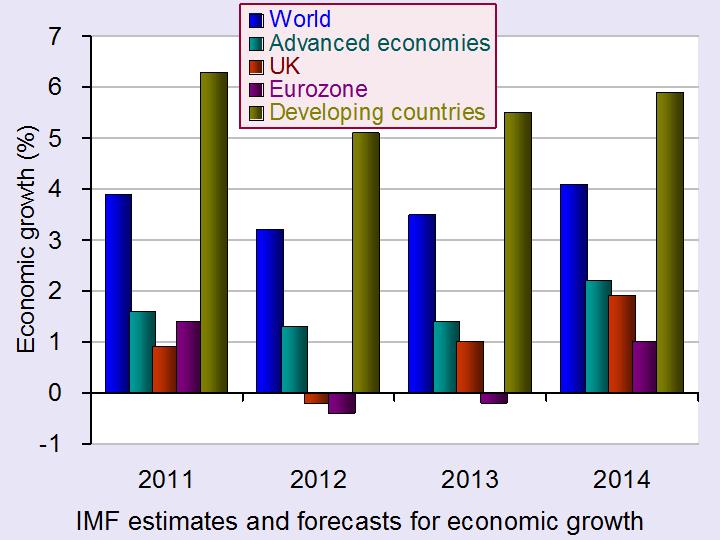 But perhaps ‘optimistic’ is an overstatement. ‘Less pessimistic’ might be a better description. As Christine Lagarde, head of the IMF, pointed out in her speech:
But perhaps ‘optimistic’ is an overstatement. ‘Less pessimistic’ might be a better description. As Christine Lagarde, head of the IMF, pointed out in her speech:
The recovery is still weak, and uncertainty is still high. As the IMF announced just a few hours ago in our World Economic Outlook, we expect global growth of only 3½ percent this year, not much higher than last year. The short-term pressures might have alleviated, but the longer-term pressures are still with us. (Click here for transcript).
In both her speech and her press conference, she went on to outline the policies the IMF feels should be adopted to achieve sustained global growth.
The articles below summarise the outcomes of the Forum and some of the views expressed.
Articles
Too soon for sighs of relief Deutsche Welle, Andreas Becker (27/1/13)
Davos 2013: The icy economic chill begins to thaw The Telegraph, Louise Armitstead (26/1/13)
 IMF Projects Modest Pick-up in Economic Growth in 2013 IMF videos, Olivier Blanchard, IMF Chief Economist (23/1/13)
IMF Projects Modest Pick-up in Economic Growth in 2013 IMF videos, Olivier Blanchard, IMF Chief Economist (23/1/13)
 Managing Director’s New Year Press Briefing IMF videos, Christine Lagarde, IMF Managing Director
Managing Director’s New Year Press Briefing IMF videos, Christine Lagarde, IMF Managing Director
Mark Carney in Davos: what’s up next for the global economy Maclean’s (Canada), Erica Alini (26/1/13)
World Economic Forum ends on warning note over ‘complacency’ The Guardian, Graeme Wearden (26/1/13)
Angela Merkel tells Davos austerity must continue The Guardian, Graeme Wearden and Larry Elliott (24/1/13)
Davos 2013: A ‘sigh of relief’ at the World Economic Forum BBC News, Stephanie Flanders (27/1/13)
Happy talk The Economist (27/1/13)
Davos Man and his defects The Economist, Schumpeter (26/1/13)
Davos: are the captains of capitalism finally paying attention? The Observer (27/1/13)
Official site
The Global Agenda 2013 The World Economic Forum
IMF projections
Modest Growth Pickup in 2013, Projects IMF IMF Survey Magazine: In the News (23/1/13)
World Economic Outlook Update IMF (23/1/13)
Questions
- Why was the mood at the WEF less pessimistic than in 2012?
- What threats remain to sustained global recovery?
- What policies are being recommended by Christine Lagarde of the IMF? Explain the reasoning behind the recommendations.
- What disagreements are there between global leaders on the scope for fiscal and monetary policies to stimulate economic growth?
- In her press conference, Christine Lagarde stated that “the teams here have concluded that the fiscal multipliers were higher in the context of that unbelievable international crisis”. Do you agree with this statement? Explain.
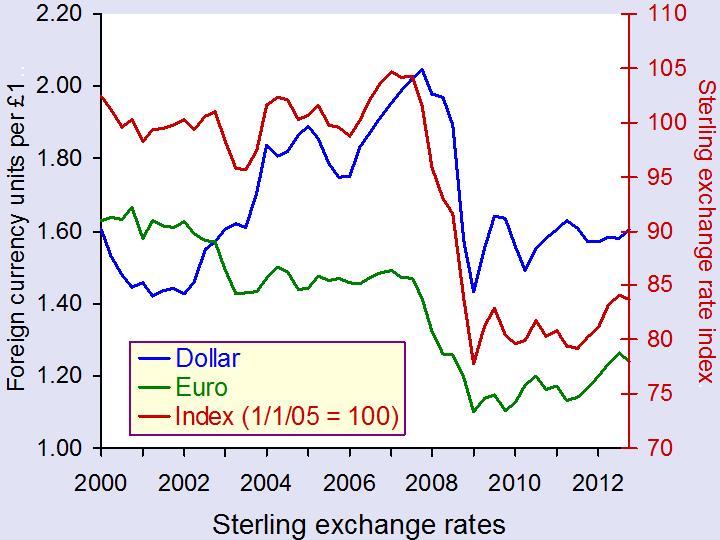 The exchange rate for sterling is determined in much the same way as the price of goods – by the interaction of demand and supply.
The exchange rate for sterling is determined in much the same way as the price of goods – by the interaction of demand and supply.
When factors change that cause residents abroad to want to hold more or fewer pounds, the demand curve for sterling will shift. If, instead, factors change that cause UK residents to want to buy more or less foreign currency, then the supply curve of sterling will shift. It is these two curves that determine the equilibrium exchange rate of sterling.
There are concerns at the moment that sterling is about to reach a peak, with expectations that the pound will weaken throughout 2013. But is a weakening exchange rate good or bad for the UK?
 With lower exchange rates, exports become relatively more competitive. This should lead to an increase in the demand for UK products from abroad. As exports are a component of aggregate demand, any increase in exports will lead to the AD curve shifting to the right and thus help to stimulate a growth in national output. Indeed, throughout the financial crisis, the value of the pound did fall (see chart above: click here for a PowerPoint) and this led to the total value of UK exports increasing significantly. However, the volume of UK exports actually fell. This suggests that whilst UK exporters gained in terms of profitability, they have not seen much of an increase in their overall sales and hence their market share.
With lower exchange rates, exports become relatively more competitive. This should lead to an increase in the demand for UK products from abroad. As exports are a component of aggregate demand, any increase in exports will lead to the AD curve shifting to the right and thus help to stimulate a growth in national output. Indeed, throughout the financial crisis, the value of the pound did fall (see chart above: click here for a PowerPoint) and this led to the total value of UK exports increasing significantly. However, the volume of UK exports actually fell. This suggests that whilst UK exporters gained in terms of profitability, they have not seen much of an increase in their overall sales and hence their market share.
Therefore, while UK exporters may gain from a low exchange rate, what does it mean for UK consumers? If a low exchange rate cuts the prices of UK goods abroad, it will do the opposite for the prices of imported goods in the UK. Many goods that UK consumers buy are from abroad and, with a weak pound, foreign prices become relatively higher. This means that the living standards of UK consumers will be adversely affected by a weak pound, as any imported goods buy will now cost more.
It’s not just the UK that is facing questions over its exchange rate. Jean-Claude Junker described the euro as being ‘dangerously high’ and suggested that the strength or over-valuation of the exchange rate was holding the eurozone back from economic recovery. So far the ECB hasn’t done anything to steer its currency, despite many other countries, including Japan and Norway having already taken action to bring their currencies down. Mario Draghi, the ECB’s president, however, said that ‘both the real and the effective exchange rate of the euro are at their long-term average’ and thus the current value of the euro is not a major cause for concern.
So, whatever your view about intervening in the market to steer your currency, there will be winners and losers. Now that countries are so interdependent, any changes in the exchange rate will have huge implications for countries across the world. Perhaps this is why forecasting currency fluctuations can be so challenging. The following articles consider changes in the exchange rate and the impact this might have.
A pounding for sterling in 2013? BBC News, Stephanomics, Stephanie Flanders (17/1/13)
UK drawn into global currency wars as slump deepens Telegraph, Ambrose Evans-Pritchard (16/1/13)
Foreign currency exchange rate predictions for GBP EUR, Forecasts for USD and NZD Currency News, Tim Boyer (15/1/13)
Euro still looking for inspiration, Yen firm Reuters (16/1/13)
Daily summary on USD, EUR, JPY, GBP, AUD, CAD and NZD International Business Times, Roger Baettig (16/1/13)
UK inflation bonds surge on Index as pound falls versus euro Bloomberg, Business News, Lucy Meakin (10/1/13)
Questions
- Which factors will cause an increase in the demand for sterling? Which factors will cause a fall in the supply of sterling?
- In the article by Stephanie Flanders from the BBC, loose monetary policy is mentioned as something which is likely to continue. What does this mean and how will this affect the exchange rate?
- Explain the interest- and exchange-rate transmission mechanisms, using diagrams to help your answer.
- If sterling continues to weaken, how might this affect economic growth in the UK? Will there be any multiplier effect?
- What is the difference between the volume and value of exports? How does this relate to profit margins?
- Why are there suggestions that the euro is over-valued? Should European Finance Ministers be concerned?
- Should governments or central banks intervene in foreign exchange markets?
- If all countries seek to weaken their currencies in order to make their exports more competitive, why is this a zero-sum game?
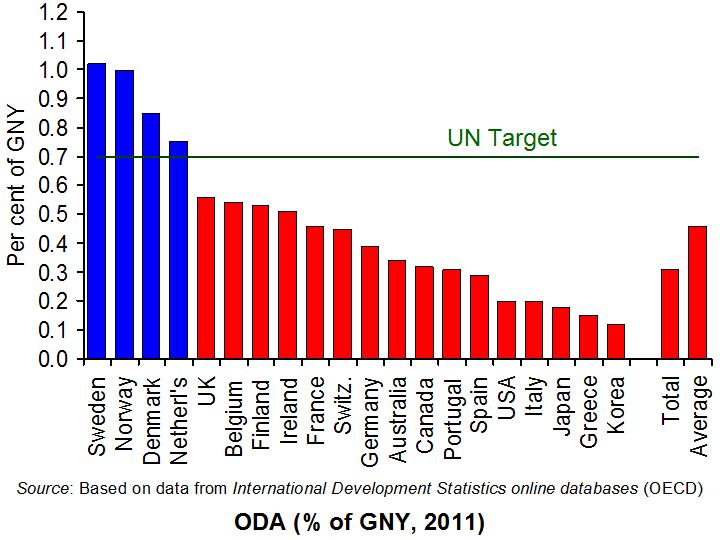 Many rich countries have made repeated commitments to the United Nations to give at least 0.7% of their gross national income (GNY) as international aid – or ‘official development assistance (ODA)’ as it is known. The first such commitments were made in 1970. Despite this, many of these countries’ aid to developing countries falls well short of the target.
Many rich countries have made repeated commitments to the United Nations to give at least 0.7% of their gross national income (GNY) as international aid – or ‘official development assistance (ODA)’ as it is known. The first such commitments were made in 1970. Despite this, many of these countries’ aid to developing countries falls well short of the target.
In fact the average amount given in aid in 2011 by the 23 donor countries which are members of the OECD’s Development Assistance Committee (DAC) was a mere 0.31% of GNY, with the USA, the biggest donor in absolute terms, giving only 0.2% of GNY. (Click here for a PowerPoint of the chart.) Since 2003, the DAC average has been 0.29% as compared with 0.30% between 1970 and 2002.
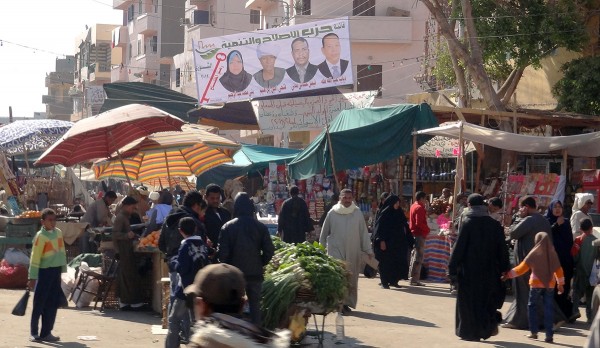 In 2005, at the Gleneagles G8 summit, the 15 members of the EU which are Development Assistance Committee members committed themselves to reaching an ODA target of 0.51% of GNY in 2010 and to reach the 0.7% target by 2015. In 2011, the UK’s ODA/GNY ratio stood at 0.56% and so was above the EU target.
In 2005, at the Gleneagles G8 summit, the 15 members of the EU which are Development Assistance Committee members committed themselves to reaching an ODA target of 0.51% of GNY in 2010 and to reach the 0.7% target by 2015. In 2011, the UK’s ODA/GNY ratio stood at 0.56% and so was above the EU target.
Section 18 of the Coalition agreement pledges that the UK government will meet the 0.7% target by 2013 – a pledge initially made by the Labour government. So far, the government has stuck to this pledge and the aid budget has escaped cuts.
But with other parts of government expenditure facing cuts, pressure is mounting on the government to reduce the aid budget. There are two main parts to the argument. The first is that aid should face its ‘fair share’ of the cuts. The second is that aid is often an inefficient way of tackling poverty in developing countries and, when discussing aid, the focus should be on getting value for money rather than on the simple total amount of aid.
The following articles look at arguments for and against meeting aid targets and examine ways of making aid ‘smarter’.
Articles
Money may be tight, but ‘smart aid’ to developing countries can really work The Guardian, Larry Elliott (13/1/13)
International aid, but not as we know it The Guardian, Andy Sumner and Richard Mallett (31/12/12)
One in four support Britain’s foreign aid policies The Telegraph, Ben Leach (29/12/12)
Why is so much UK aid money still going to companies based in Britain? The Guardian, Claire Provost and Nicola Hughes (21/9/12)
Is the 0.7% aid target still relevant? The Guardian, Niels Keijzer (2/8/12)
What’s wrong with foreign aid? The Spectator (3/1/13)
Five reasons to deliver and legislate on international aid bond, UKAN (6/12)
The Political Economy of Bilateral Foreign Aid Working Knowledge, Harvard Business School, Eric D. Werker (4/1/13)
Misconceptions about aid Dawn (Pakistan), Niaz Murtaza (8/1/13)
Why political short-sightedness and randomised control trials can be a deadly mix for aid effectiveness Vox EU, Anders Olofsgård (13/10/12)
Aid in troubled times DfID, Paul Collier (2/7/12)
Data and information
Aid Effectiveness data World Bank
Aid statistics OECD
Aid effectiveness OECD
Aid Wikipedia
Questions
- What was agreed at the Gleneagles G8 summit?
- Examine the argument that aid crowds out private investment.
- Compare the relative benefits of tied and untied aid.
- Give some examples of ‘smart aid’.
- How would you establish whether or not it is ‘fair’ to cut the aid budget?
- Give three arguments for maintaining the aid budget and three arguments for cutting it. On which side do you come down and why?
 With many countries struggling to recover from the depression of the past few years, central banks are considering more and more doveish moves to kick-start lending. But with short-term interest rates in the USA, the UK and Japan close to zero, the scope for further cuts are limited. So what can central banks do?
With many countries struggling to recover from the depression of the past few years, central banks are considering more and more doveish moves to kick-start lending. But with short-term interest rates in the USA, the UK and Japan close to zero, the scope for further cuts are limited. So what can central banks do? The second option is to increase quantitative easing. Although in a minority at the last MPC meeting, Mervyn King, the current Bank of England Governor, argued for a further £25 billion of asset purchases (bringing the total to £400bn) (see MPC minutes paragraph 39). It is highly likely that the MPC will agree to further QE at its next meeting in March. In Japan, the new governor of the Bank of Japan is expected to include asset purchases as part of the policy of monetary easing.
The second option is to increase quantitative easing. Although in a minority at the last MPC meeting, Mervyn King, the current Bank of England Governor, argued for a further £25 billion of asset purchases (bringing the total to £400bn) (see MPC minutes paragraph 39). It is highly likely that the MPC will agree to further QE at its next meeting in March. In Japan, the new governor of the Bank of Japan is expected to include asset purchases as part of the policy of monetary easing. One other approach, mooted by the Bank of England’s Deputy Governor before the House of Commons Treasury Select Committee, is for negative interest rates paid on Banks’ reserves in the Bank of England. This would, in effect, be a fee levied on banks for keeping money on deposit. The idea would be to encourage banks to lend the money and not to keep excessive liquidity. As you can see from the chart, three rounds of quantitative easing have led to a huge increase in bank’s reserves at the Bank of England. (Click here for a PowerPoint of the chart.)
One other approach, mooted by the Bank of England’s Deputy Governor before the House of Commons Treasury Select Committee, is for negative interest rates paid on Banks’ reserves in the Bank of England. This would, in effect, be a fee levied on banks for keeping money on deposit. The idea would be to encourage banks to lend the money and not to keep excessive liquidity. As you can see from the chart, three rounds of quantitative easing have led to a huge increase in bank’s reserves at the Bank of England. (Click here for a PowerPoint of the chart.)








